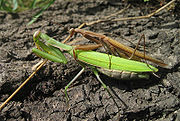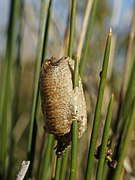螳螂
| 螳螂目 化石时期: 白垩纪–至今
| |
|---|---|

| |
| 科学分类 | |
| 界: | 动物界 Animalia |
| 门: | 节肢动物门 Arthropoda |
| 纲: | 昆虫纲 Insecta |
| (未分级): | 双髁类 Dicondylia |
| 亚纲: | 有翅亚纲 Pterygota |
| 演化支: | 伴翅类 Metapterygota |
| 下纲: | 新翅下纲 Neoptera |
| 演化支: | 复新翅类 Polyneoptera |
| 总目: | 网翅总目 Dictyoptera |
| 目: | 螳螂目 Mantodea Burmeister, 1838 |
| 科 | |
| 异名 | |
| |
螳螂(Mantis),又叫“刀螂”。泛称螳螂目(Mantodea)下的昆虫,目前共计超过2400种,分布于15科、约430属当中,其中种类数量最多的科为螳螂科。
螳螂与蜚蠊目同属于网翅总目中的一员。有些螳螂在外型上与竹节虫(竹节虫目)、蝗虫(直翅目)或是螳蛉(脉翅目)相似,因而易被混淆。多数螳螂为伏击型掠食者,部分种类则会主动追击猎物。一般而言,螳螂的寿命约一年,在一年一世代的种类中,雌螳螂通常于秋季产下卵鞘后死亡,其后代则受卵鞘的保护以度过冬季。
螳螂分布范围广泛,从温带到热带皆有种类居住。多数种类头部呈三角形且可灵活转动,其头部两侧通常有着巨大的复眼。多数种类身体细长,部分种类的成虫没有外观上完整且易于观察的翅膀。但所有螳螂皆具备膨大、并可以攫取猎物的前足。
有些种类在休息时会呈现看似直立的姿势,并将前足收起于前胸之前,而螳螂因为这样特殊的姿势,在某些语言中被称为“祈祷虫”,例如葡萄牙文中的螳螂(louva-a-deus)意思即为“向神祈祷”。有些早期文明认为螳螂具有超自然力量,例如:古希腊、古埃及和亚述。部分种类的雌虫有性食行为,会攻击并取食受性费洛蒙吸引而来的雄虫,因此在某些文化中,雌螳螂常被作为“致命情人”的象征。此外,螳螂也是相当受欢迎的宠物昆虫之一。
螳螂的分类与演化[编辑]
螳螂目目前共计约430属,超过2400种[1]。大部分种类分布于热带区域,有少部分分布于温带[2][3]。
螳螂目在系统分类学上的地位曾有过多次的重大更动,目前的分科方式是以马克斯·贝耶于1968年所建立的8科系统为蓝本逐步修改而来[4]。螳螂曾经与竹节虫(竹节虫目)、蟑螂(蜚蠊目)和螳䗛(螳䗛目)一同被归于直翅目之下。1991年,克里斯滕森将螳螂以螳螂亚目的位阶,与蟑螂、白蚁一同置入网翅目之下[5][6]。
克拉斯(Klaus-Dieter Klass)于1997年研究雄性的外生殖器形态后,认为缺爪螳科和金属螳科在很早以前就已经与其他类群分道扬镳[7]。此外,近期的分子证据指出许多类群如螳科、攀螳科和细足螳科等等皆非单系群[8],因此螳螂科级的亲缘关系仍然有待科学家持续修订[9]。
同样具有捕食性前足的螳蛉,外观上常与螳螂混淆,但此特征其实是趋同演化的结果。螳蛉并无与螳螂类似的革质化前翅[10]。
生物学[编辑]
解剖学[编辑]
头部[编辑]

多数螳螂的头部大致上呈倒三角形,复眼多位于头部上侧的两端,具备三个简单眼以及两根触角,其口器多为下口式(hypognathous),且通常具备尖锐而有力的大颚[11]。
螳螂头部之于其他网翅类群最不同的地方在于:螳螂头部与前胸连接处十分柔软有弹性,让螳螂的头部能够转动,不少种类甚至有达180°的转动范围[12]。
胸部[编辑]
螳螂的胸部三节(前胸、中胸及后胸)外观上清楚可见,分别连接着前足、中足以及后足,其中连接着捕捉足的前胸,更是螳螂分类上的重要形态特征之一。螳螂的前胸背板被一条凹陷可见的基节上横沟划分成两的区域,分别称作沟前区和沟后区,而“前胸被凹陷的横沟分区”的此一特征乃是螳螂的自衍征之一,不可见于其他昆虫[13]。除了似螳属(Mantoida)之外,绝大多数种类的前胸背板长度大于中、后胸背板。而前胸背板与前足的连接处十分柔软有弹性,可以允许前足有极大的转动范围,但中、后足的可转动范围相较于前足极其有限[14][15]。
螳螂分类上另一个重要的形态特征是其前足,多数种类的前足上带有许多细小的刺,在捕捉猎物时可用以限制猎物的行动,又因捕食的功能亦被称作“捕捉足”。螳螂的足与多数昆虫一样,共可分成五个小节,从连接身体处到最末端分别为:基节、转节、腿节、胫节、跗节。其中,捕捉足的基节和转节相当发达,其体积通常远大于中、后足的基节和转节,而在相对比例上,前足基节的长度通常与前足腿节相当,但中、后足的腿节长度却远远大于中、后足的基节(如图)。

螳螂的前足腿节上通常可见三排刺,分别为前腹侧刺(anteroventral spines)、后腹侧刺(posteroventral spines)以及基盘刺(discoidal spines)[16]。除了金属螳属(Metallyticus)之外[17],所有螳螂的前足腿节上都有一排可见的端刺,位置约在腿节腹侧(Ventral)中央偏身体侧,数量从1到5根不等,因种类而异[17]。在前腹侧刺和端刺中间通常有个凹槽,称作胫节爪沟。
前足腿节的前腹侧刺和后腹侧刺之可见数量总和则会因种类不同而有极大的差异,从近30根的缺爪螳属(Chaeteessa)到1根都没有的怪螳族(Amorphoscelinae)都有[16]。
前足胫节则通常可见两排刺,为前腹侧刺和后腹侧刺,无端刺。其刺的数量也因种类而异有着极大的变化。几乎所有种类的胫节末端都有一根巨大而突起的端爪(apical spur),在平时腿节与胫节交叠时收于腿节的胫节爪沟中,其收起时的姿势犹如祈祷者一般。
前足跗节通常由五个可见的跗小体(tarsomeres)所组成,除了异跗螳属(Heteronutarsus)之外[16]。跗节的主要功能为步行,并不参与捕食,其末端有一对爪(unguis)[16],没有爪间体(arolium)[14][18]。
螳螂依其翅型大致上可分为四种类型:长翅型(macropterous)、短翅型(brachypterous)、微翅型(micropterous)、无翅型(apterous)。排除无翅型不谈,一般螳螂的翅膀共有两对,前翅生于中胸而后翅生于后胸。前翅的革质化程度较高,较后翅坚硬且多具色彩,有些种类的前翅色彩为螳螂提供了隐蔽性,有助于融入环境;后翅的膜质化程度较高,较前翅柔软脆弱且多为透明,主要功能为飞行[14][19]。
腹部[编辑]
所有螳螂的腹部背侧由10片背板(tergites)组成,雄虫的腹侧可见腹板有9片、雌虫则为7片,两性的腹部末端皆有两根尾毛(cerci),雄虫第9片腹板的末端有两根尾针(styli)[14]。
视觉[编辑]
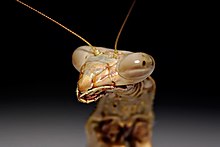
螳螂具有立体视觉[20][21][22],可以定位猎物的位置。其复眼由约10,000 个小眼所构成,其中视觉最敏锐的部分位于中央窝(fovea)附近,可提供高分辨率的影像。而周边区域的小眼则主要负责动态视觉,当周围有任何风吹草动时,其头部可以快速旋转,使目标进入中央窝的视野,并可透过头部的摆动反复调整对焦,利用高分辨率的中央窝持续追踪猎物的一举一动[18][23]。螳螂的两个复眼分离且并陈于头部上方的两端,为螳螂提供了开阔的双眼视野和精确的近距离立体视觉对焦[24]。此外,在观察螳螂时,会发现其复眼上有一黑点看起来一直“注视”著观察者,该黑点称作伪瞳孔(pseudopupil)。而伪瞳孔的产生,是因为部分的小眼在吸收入射光后却没有反射光线到观察者的瞳孔中[25]。
螳螂的小眼为并列眼(apposition eye),拥有这种类型复眼的昆虫多半被认为是日行性 [26],但并不全然如此,许多昆虫的并列眼也有夜间适应的能力[27],例如某些蟑螂和螳螂。某些螳螂的复眼在夜间适应与日间适应下会有不同颜色,通常在夜间适应时的颜色较深,其原因可能是因为色素在夜间适应下会移动到末端主要色素细胞(distal primary pigment cells)[28]。而根据Schirmer和Prete等人的研究显示[29],螳螂在日间的活跃程度仅高出夜间些许,其活动高峰期位于黄昏时分。许多种类的螳螂也会在夜间受人工光源的吸引而飞行或步行趋光而来,借由趋光性而捕捉到的螳螂几乎全为雄性[30],可能因为雌螳螂的移动能力普遍远低于雄螳螂。
食性与捕食[编辑]

螳螂为广食性的节肢动物捕食者[2],在自然状况下只取食活着的猎物,它们取食的范围广泛,从比自己体型小的同类,到小型脊椎动物都有,例如:蜘蛛、蜥蜴、青蛙、小型鸟类,或鱼类 少部分吃草[31][32][33]。大部分种类的螳螂都是守株待兔型的掠食者,通常它们会静候猎物经过、或是以缓慢的速度接近[34],在猎物进入螳螂的攻击范围后,它们会以捕捉足高速抓取猎物[35],而在极度饥饿的情况下,有时也会主动攻击被侦测到的猎物[36]。有些种类的螳螂属于主动出击型的掠食者,特别是地栖型的小型种类,例如:Entella、Ligaria、Ligariella 和Yersiniops等都会在干燥的沙地上搜索猎物,其行为酷似虎甲虫[14]。

有些螳螂的前肠(fore gut)的长度极长,有极大的空间可以暂存食物以俟消化,这可能对需要快速进食的昆虫来说有所助益[37]。此外,曾有研究指出大刀螳在被允许取食花粉的情况下,寿命更长、成长更快、且产下更多子代[38]。

御敌适应[编辑]
螳螂的天敌包含蝙蝠、蛙类、蜥蜴、鸟类,大型鼠类,以及蜘蛛和蚂蚁等无脊椎动物[39]。几乎所有螳螂的初级防御都属于伪装,大部分物种皆拥有绝佳的保护色,为螳螂提供优秀的隐蔽效果,例如:像雨林底层落叶的枯叶螳属(Deroplatys)、神似叶片的叶背螳属(Choeradodis)等等,如此可避免遭捕食,也有更大的机会可以捕猎猎物[40]。花螳螂属(Hymenopus)中有些种类不仅形态酷似花朵,其身体所反射的紫外线波段也正好在蜜蜂科的视觉光谱范围内[41],被认为可能有利于吸引访花昆虫前来,故有些研究者将其归类于攻击型拟态[42][43][44]。但也有研究者认为,兰花螳螂(Hymenopus coronatus)的紫外线反射光谱与其栖息地大多数的花朵的光谱皆不同,并没有特定的拟态对象,不符合拟态中需存在模仿物种与被模仿物种的定义,因此不赞同称之为攻击型拟态的说法[45]。
部分种类的螳螂有着体色多型性(body-color polymorphism)的特性,在相同龄期的不同个体上可以见到不同体色。最常见的体色变异是棕色与绿色、以及介于棕与绿之间的渐层色。此外,同一个体在不同龄期间也可能会有体色的转换,例如线纹巨螳(Sphodromantis lineola)[46]以及薄翅螳(Mantis religiosa)[47]的若虫被认为会因环境光线的强度差异而在不同龄期的转变过程中改变体色、而影响埃及螳螂(Miomantis paykullii)颜色改变的主要因素则是环境的湿度[46][48]。而有些非洲和澳洲的物种会在干季末期后蜕皮转为黑色,得以帮助它们在大火后的焦土之中藏身(火性黑变,fire melanism)[49]。而有些类群的一龄若虫甚至长得非常像蚂蚁,被认为在形态上可能拟态蚂蚁[50],例如:齿螳属(Odontomantis)和Mantillica [51]的若虫。
有些螳螂在步行或是静止时,会伴随着摇摆身体的行为,这种行为可能可以增进螳螂的隐匿效果,使螳螂看起来宛如随风摇曳的枝叶。不过,这种行为可能还有个更重要的功能,透过摇摆所产生的视角差能让螳螂更容易分辨眼前物体的远近,或许对于时常守株待兔的螳螂而言,摇摆是帮助螳螂看清周遭事物的重要行为[52]。

当初级防御仍无法阻止天敌进逼时,螳螂会启动次级防御,其防御方式大致可分为三大类:威吓、逃跑及装死。许多种类的螳螂都会威吓,它们会伸直中足、挺起前胸、高举前足、扬起翅膀,以近似于站立的姿态面向来犯的天敌,使得螳螂看起来比原本还大。此外,有些种类的前胸腹侧、前足内侧和后翅上有鲜艳的色彩或图案,借由突如其来的展示这些显眼的部位,来惊吓或吓阻天敌。有些种类甚至可以透过从腹部的气孔中加压排出空气来发出“嘶嘶”声,例如静螳属(Statilia)的成员。如果来自天敌的威胁尚未解除,威吓中的螳螂可能会用前足尝试攻击敌人。若依然无法劝退天敌,则螳螂会选择拔腿就跑、有些种类甚至会装死来骗过天敌,例如姬螳属(Acromantis)的种类。
除此之外,螳螂有一项特别的次级防御。有些螳螂的听器能够接收蝙蝠发出的超音波,随着蝙蝠逼近,螳螂所接收的超音波频率也会跟着上升,而螳螂在夜间飞行时,如果听器接收到频率渐渐提高的超音波,它们会转为螺旋下坠飞行,藉以躲避蝙蝠的攻击,即使被蝙蝠擒住,螳螂也会举起捕捉足奋力尝试挣脱[53][54][49][55][56]。
繁殖史和生活史[编辑]
在温带地区,螳螂的繁殖季节通常在秋季[57][58],而在热带地区则没有明显的繁殖季,几乎全年皆可繁殖[58]。当准备交尾时,雄虫会从背后跳上雌虫,以前足钳住雌虫的胸及翅基,有些种类例如刀螳等,在上背之后,会以两根触角会快速敲击雌虫[59],接着雄虫会向左侧弓起腹部,搜索雌虫的交尾器,并将精苞送入雌虫体内。雌虫产下的卵会被其分泌的泡沫包覆,当外层硬化后会形成一个保护壳。螳螂的卵鞘又称为螵蛸,一颗螵蛸约包含10至400颗卵,不同物种产卵数各异。不同物种的螳螂会将螳螂卵产于不同地方,有些物种会将螵蛸产于扁平表面上、包覆于植物上,或直接产于地上。尽管螵蛸构造精巧,且具有相对坚硬的外壳,但仍然常为其他物种所取食,如寄生蜂等。丽艳螳科的部分物种发展出了护卵行为,雌虫会守在卵旁边避免掠食[60]。Tarachodes maurus 的体色酷似树皮,在护卵期间会以其腹部盖住卵块。在若虫孵化之前,雌虫除伏击经过的猎物外,不会作太多的动作[5]。分布于美国南方的北美竹节螳(Brunneria borealis)则演化出了孤雌生殖的能力,不需与雄虫交配即能生产子代[2]。非洲绿巨螳(Sphodromantis viridis)和某些纤螳属(Miomantis)物种也有孤雌生殖的能力,但它们通常都采取有性生殖[61][62][63]。温带气候区的物种成虫无法活过冬季,其卵块在冬季则会进入休眠,于春季孵化[6]。
螳螂属于网翅总目(Dictyoptera),该总目成员皆属于不完全变态的昆虫,其生活史会经过卵、若虫、成虫三个阶段。小型种类的卵约3-4周便会孵化,大型种类则约4-6周。成长过程中不光是体型会有变化,体色也可能会有剧烈的转变,例如幼期的蚂蚁拟态、以及龄期间的体色转换。螳螂依种类不同,需蜕皮5-10次方可进入成虫阶段,且在每次转龄后不会吃掉自己蜕下的外骨骼。在成虫后,大多数的种类会拥有翅膀,通常雄性的翅膀比雌性的发达。若虫期的长度则会因种类而异,小型种类可以短至4-8周、大型种类可能长至4-6个月才会长成成虫[2][15]。
-
交尾中的薄翅螳(Mantis religiosa),上方褐色者为雄虫,下方绿色者为雌虫。
-
产卵中的卡罗莱纳螳螂(Stagmomantis carolina)。
-
薄翅螳的新鲜螵蛸。
-
典型的螳螂螵蛸常产于树丛细枝上。
-
刚孵化的小螳螂。
性食[编辑]
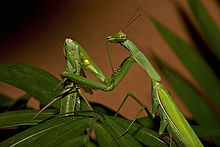
性食(sexual cannibalism),意指生物(通常为雌性)在交配前、中、或后攻击及取食交配对象的行为[64]。
综观螳螂目,交配行为在学术文献中已有纪录者共有38种[65][66][67][68][69][70],其中有7种未被观察到有性食行为的发生。相对于整个目共2400种而言,当前仅仅38种的采样难以为性食在螳螂目中的演化过程给出适当的解释。不过螳螂作为宠物昆虫,被饲养以及被观察过交配行为的种类数量不仅仅只有这38种而已[71],许多类群都曾观察过性食的发生,只是其观察结果未曾收录进学术型文章中。综观全目,应该还是以有潜力发生性食的种类占大多数,但是性食现象在螳螂目的演化过程中何时发生、是否为单起源、为何发生等问题,目前仍未有具体的答案。
| 有性食之种类 | 几乎没有或无性食之种类 | |
|---|---|---|
| 棘螳科 Acanthopidae |
|
|
| 花螳科 Hymenopodidae | Odontomantis ornata | |
| 攀螳科 Liturgusidae | Humbertiella similis | |
| 螳科 Mantidae |
|
|
| 苔癣螳科 Sibyllidae | 苔藓螳螂 Sibylla pretiosa | |
| 丽艳螳科 Tarachodidae | Tarachodes afzelii | |
| 细足螳科 Thespidae | Oligonyx insularis |
古生物学[编辑]
螳螂化石的出土类群不多,截至2007为止,仅有25个化石种类被发表[9]。目前最早的螳螂化石发现于西伯利亚,约有一亿三千五百万年的历史[9]。其中一笔来自日本的白垩纪琥珀化石在前脚上有刺,与现生物种相符[74]。大多数琥珀中的螳螂化石为若虫,模式标本的化石中发现成虫的比例则相对较高。在2003年,巴西克拉图组地层出土的1公分长的 Santanmantis axelrodi,相较于现生的螳螂,古螳螂在捕捉足上的刺较不发达。
相关文化[编辑]
文学及艺术[编辑]
早在周代,螳螂即已见诸文学作品之中,例如《庄子》等[75]。宋代唐慎微《证类本草》则对螳螂的螵蛸、生活史、解剖学,以及触角功能有精确的描述[76]。古希腊对于螳螂的记述较少,但在前5世纪的银币上,如西西里的梅塔庞托的德拉克马等,就已经清楚刻绘母螳螂的警戒姿势[77]。10世纪时,拜占庭时期的《苏达辞书》有描述前臂较长且移动缓慢的绿色蝗虫[78],该书将柴乐诺波采集的俗语中有关螳螂形象的部分,解释为形同枯槁的女性[79]。
一直到18世纪,西方世界才对螳螂的生物学及形态学进行较精确的描述。罗瑟·冯·卢森霍夫在其著作《有趣的昆虫》(Insekten-Belustigungen)中描述了螳螂及其同类相食行为[80]。

阿道斯·赫胥黎在其1962年的小说《岛》中,借由描述了小提琴螳螂(Gongylus gongylodes)性食的天性,对于死亡的本质进行哲学探讨。自然学家杰拉德·杜瑞尔(Gerald Durrell)在其1956年的自传性著作《追逐阳光之岛》(My Family and Other Animals)中,用四页描述了一场螳螂与壁虎间的战斗。在这场生死斗即将揭晓前,杜瑞尔说道:
它(壁虎杰罗尼莫)扑向螳螂,使她蜷起身躯,再用它的下颚钳着她胸节下方。西塞莉(螳螂)则用它的前脚夹住杰罗尼莫的两只后脚进行反击。它们从天花板,一路激战到了墙上,弄得沙沙作响。彼此都在设法提升自身的优势。[81]
莫里兹·柯尼利斯·艾雪的版画作品《梦》(Dream)描绘了一个与人等高的巨型螳螂站在一个沉睡的主教身边[82]。1957年怪兽电影《致命螳螂》(The Deadly Mantis)的主角则为一个巨大螳螂。
螳螂在文化上常被用作譬喻致命女郎。这个观点在Cable、Guy and Rodd、LeLievre、T. McCracken,以及Mark Parisi的卡通漫画内都有出现过[83][84][85][86]。伊莎贝拉·罗塞里尼在短片《绿色春宫》(Green Porno)中,曾经扮演过螳螂[87][88]。
武术[编辑]

中国武术中有数支拳法以螳螂为名[89][90],如北派螳螂拳[91]及南派螳螂拳[90]等等。两者皆在中国广为流行,甚至流传西方[90][91][92][93]。
宗教及神话[编辑]
非洲南部的科伊科伊人和桑人有螳螂崇拜的文化。波耳人甚至将螳螂称为“科伊科伊人的神”(南非语:Hottentotsgot)[94]。但其实对桑人而言,螳螂仅是创世神卡根(Cagn)的众多化身之一。卡根的其他化身还包含蛇、野兔,以及秃鹫等等[95]。许多古文明认为昆虫具有超自然力量,希腊人认为螳螂可以为迷航者导航;古埃及人的《死者之书》则记载螳螂可以引领灵魂到冥界;在尼尼微一份前9世纪的蝗虫(buru,当时人将螳螂归类蝗虫)名录的辞书中有螳螂的纪录,称螳螂为“招魂虫”(buru-enmeli)及“占卜虫”(buru-enmeli-ashaga)[80][96]。
宠物饲养[编辑]
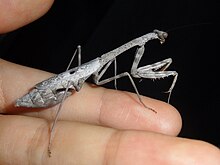
螳螂为常见的宠物昆虫[97][98],但由于螳螂的寿命仅有一年左右,因此饲养者时常也在同时进行繁殖。在1996年时,螳螂研究组(Mantis Study Group)的成员在养殖的物种即至少有50种[71]。《独立报》的宠物版报导了饲育勇斧螳的文章[99]。《每日邮报》也曾登出饲育非洲芽翅螳螂的文章[100]。
害虫控制[编辑]
从事有机农业的园艺工作者有时会使用螳螂来意图控制农业害虫[101]。但螳螂其实并非生物防治的理想物种[101],因其繁殖速度不足以应付害虫[101],且其捕食对象并无专一性,会同时捕杀农业益虫[102]。中华大刀螳及薄翅螳曾被引入北美洲进行害虫控制,但后来却造成物种入侵[103]。
螳螂机器人[编辑]
螳螂机器人的原型乃受到螳螂捕捉足的启发,其功能可以行走、爬楼梯和抓取物体。多个可以转动的关节为螳螂机器人的脚提供了很高的灵巧性,未来的模型可能会进一步模仿前足上的刺,以增加抓取的性能、以及增加抓取食的载重能力[104]。
辞源[编辑]
早在周代,螳螂即已见诸文学作品之中,例如《庄子》[75]。根据《尔雅》纪载,螳螂在古代汉语中又有“螗螂”、“不过蟷蠰”等称呼[105]。而英文“Mantis”则源自古希腊文“μάντις”,意为“先知”。1838年,德国昆虫学家赫尔曼·布尔迈斯特在命名该目时,将“Mantis”加上拉丁化希腊文字尾“eidos”(εἶδος,意指“形态”),组合成“Mantodea”一词。[106][107]
影视形象[编辑]
- 《假面骑士空我》 - 未确认生命体36号(B群6号) / Me·Garima·Ba
- 《假面骑士剑》 - 假面骑士圣杯(Chalice) / 红心A技能 - 变身
- 《假面骑士OOO》 - “螳螂”核心硬币
- 《假面骑士REVICE》 - “螳螂”罪恶印章及基因组
参考文献[编辑]
- ^ Otte, Daniel; Spearman, Lauren. Mantodea Species File Online. [2012-07-17]. (原始内容存档于2012-01-25).
- ^ 2.0 2.1 2.2 2.3 Hurd, I. E. Ecology of Praying Mantids. Prete, Fredrick R.; Wells, Harrington; Wells, Patrick H.; Hurd, Lawrence E. (编). The Praying Mantids. Johns Hopkins University Press. 1999: 43–49. ISBN 978-0-8018-6174-1.
- ^ Hurd, I. E. Mantid in Ecological Research. Prete, Fredrick R.; Wells, Harrington; Wells, Patrick H.; Hurd, Lawrence E. (编). The Praying Mantids. Johns Hopkins University Press. 1999: 231. ISBN 978-0-8018-6174-1.
- ^ Beier, M. Ordnung Mantodea (Fangheuschrecken). Handbuch der Zoologie. 1968, 4 (2): 3–12.
- ^ 5.0 5.1 Costa, James. The Other Insect Societies. Harvard University Press. 2006: 135–136 [2019-09-12]. ISBN 978-0-674-02163-1. (原始内容存档于2014-07-04).
- ^ 6.0 6.1 Capinera, John L. Encyclopedia of Entomology 4. Springer. 2008: 3033–3037. ISBN 978-1-4020-6242-1.
- ^ Klass, Klaus-Dieter. The external male genitalia and phylogeny of Blattaria and Mantodea. Zoologisches Forschungsinstitut. 1997. ISBN 978-3-925382-45-1.
- ^ Svenson, Gavin J.; Whiting, Michael F. Reconstructing the origins of praying mantises (Dictyoptera, Mantodea): the roles of Gondwanan vicariance and morphological convergence. Cladistics. 2009-10-01, 25 (5): 468–514. ISSN 1096-0031. doi:10.1111/j.1096-0031.2009.00263.x (英语).
- ^ 9.0 9.1 9.2 Martill, David M.; Bechly, Günter; Loveridge, Robert F. The Crato Fossil Beds of Brazil: Window into an Ancient World. Cambridge University Press. 2007: 236–238. ISBN 978-1-139-46776-6.
- ^ Boyden, Thomas C. Mimicry, predation and potential pollination by the mantispid, Climaciella brunnea var. instabilis (Say) (Mantispidae: Neuroptera). Journal of the New York Entomological Society. 1983, 91 (4): 508–511. JSTOR 25009393.
- ^ Mantodea. projects.ncsu.edu. General Entomology. [2020-04-06]. (原始内容存档于2020-11-14).
- ^ Praying Mantis. National Geographic Society. [2015-08-28]. (原始内容存档于2011-05-21).
- ^ Schiemenz, Hans; Klausnitzer, Bernhard. Mantodea — Fangschrecken oder Gottesanbeterinnen. Exkursionsfauna von Deutschland. Heidelberg: Spektrum Akademischer Verlag. 2011: 113–113. ISBN 9783827424518.
- ^ 14.0 14.1 14.2 14.3 14.4 Roy, Roger. Morphology and Taxonomy. Prete, Fredrick R.; Wells, Harrington; Wells, Patrick H.; Hurd, Lawrence E. (编). The Praying Mantids. Johns Hopkins University Press. 1999: 21–33. ISBN 978-0-8018-6174-1.
- ^ 15.0 15.1 Siwanowicz, Igor. Animals Up Close. Dorling Kindersley. 2009: 38–39. ISBN -978-1-405-33731-1.
- ^ 16.0 16.1 16.2 16.3 Brannoch, Sydney K.; Wieland, Frank; Rivera, Julio; Klass, Klaus-Dieter; Béthoux, Olivier; Svenson, Gavin J. Manual of praying mantis morphology, nomenclature, and practices (Insecta, Mantodea). ZooKeys. 2017-09-13, 696: 1–100 [2019-09-12]. ISSN 1313-2970. PMC 5673847
 . PMID 29200926. doi:10.3897/zookeys.696.12542. (原始内容存档于2021-02-20) (英语).
. PMID 29200926. doi:10.3897/zookeys.696.12542. (原始内容存档于2021-02-20) (英语).
- ^ 17.0 17.1 Wieland, Frank. The phylogenetic system of Mantodea (Insecta: Dictyoptera). Species, Phylogeny and Evolution - SPE. Göttingen: Göttingen University Press. 2013. ISBN 9783863951153.
- ^ 18.0 18.1 Corrette, Brian J. Prey capture in the praying mantis Tenodera aridifolia sinensis: coordination of the capture sequence and strike movements (PDF). Journal of Experimental Biology. 1990, 148: 147–180 [2019-09-12]. PMID 2407798. (原始内容存档 (PDF)于2019-09-12).
- ^ Kemper, William T. Insect Order ID: Mantodea (Praying Mantises, Mantids) (PDF). Missouri Botanical Garden. [2015-09-21]. (原始内容存档 (PDF)于2021-03-08).
- ^ Nityananda, Vivek; Tarawneh, Ghaith; Rosner, Ronny; Nicolas, Judith; Crichton, Stuart; Read, Jenny. Insect stereopsis demonstrated using a 3D insect cinema. Scientific Reports. 2016, 6: 18718. PMC 4703989
 . PMID 26740144. doi:10.1038/srep18718.
. PMID 26740144. doi:10.1038/srep18718.
- ^ Rossel, S. Binocular stereopsis in an insect. Nature. 1983, 302 (5911): 821–822. doi:10.1038/302821a0.
- ^ Rossel, S. Binocular vision in insects: How mantids solve the correspondence problem. Proceedings of the National Academy of Sciences of the United States of America. 1996, 93 (23): 13229–13232. PMC 24075
 . PMID 11038523. doi:10.1073/pnas.93.23.13229.
. PMID 11038523. doi:10.1073/pnas.93.23.13229.
- ^ Simmons, Peter J.; Young, David. Nerve Cells and Animal Behaviour. Cambridge University Press. 1999: 8990. ISBN 978-0-521-62726-9.
- ^ Howard, Ian P.; Rogers, Brian J. Binocular Vision and Stereopsis. Oxford University Press. 1995: 646. ISBN 978-0-19-508476-4.
- ^ Zeil, Jochen; Al-Mutairi, Maha M. Variations in the optical properties of the compound eyes of Uca lactea annulipes (PDF). The Journal of Experimental Biology. 1996, 199 (7): 1569–1577 [2019-09-12]. PMID 9319471. (原始内容存档 (PDF)于2009-02-25).
- ^ Arthropod eye design and the physical limits to spatial resolving power. Progress in Neurobiology. 1993-04-01, 40 (4): 413–461 [2019-09-12]. ISSN 0301-0082. doi:10.1016/0301-0082(93)90017-M. (原始内容存档于2020-11-30) (英语).
- ^ Adaptations for Nocturnal Vision in Insect Apposition Eyes. International Review of Cytology. 2006-01-01, 250: 1–46 [2019-09-12]. ISSN 0074-7696. doi:10.1016/S0074-7696(06)50001-4. (原始内容存档于2020-12-01) (英语).
- ^ Lazzari, Claudio R.; Insausti, Teresita C.; Reisenman, Carolina E. Light-induced and circadian changes in the compound eye of the haematophagous bug Triatoma infestans (Hemiptera: Reduviidae). Journal of Experimental Biology. 2002-01-15, 205 (2): 201–210 [2023-02-13]. ISSN 1477-9145. PMID 11821486. (原始内容存档于2023-07-21) (英语).
- ^ Bogue, Wil; Urdiales, Andrew F.; Mantes, Edgar S.; Prete, Frederick R.; Schirmer, Aaron E. Circadian rhythms affect electroretinogram, compound eye color, striking behavior and locomotion of the praying mantis Hierodula patellifera. Journal of Experimental Biology. 2014-11-01, 217 (21): 3853–3861 [2019-09-12]. ISSN 1477-9145. PMID 25214491. doi:10.1242/jeb.102947. (原始内容存档于2020-06-17) (英语).
- ^ Bragg, P.E. A review of the Liturgusidae of Borneo (Insecta: Mantodea). Sepilok Bulletin. 2010, 12: 21–36.
- ^ Grimaldi, David; Engel, Michael S. Evolution of the Insects. Cambridge University Press. 2005: 254. ISBN 978-0-521-82149-0.
- ^ Nyffeler, Martin; Maxwell, Michael R.; Remsen, J. V., Jr. Bird predation by praying mantises: a global perspective. The Wilson Journal of Ornithology. 2017, 129 (2): 331–344. doi:10.1676/16-100.1.
- ^ Battison, Roberto; et al. The fishing mantid: predation on fish as a new adaptive strategy for praying mantids (Insecta: Mantodea). Journal of Orthoptera Research. 2018, 27 (2): 155–158 [2019-09-13]. doi:10.3897/jor.27.28067. (原始内容存档于2021-02-25).
- ^ Ross, Edward S. Mantids—The Praying Predators. National Geographic. February 1984, 165 (2): 268–280. ISSN 0027-9358. OCLC 643483454. 参数
|magazine=与模板{{cite journal}}不匹配(建议改用{{cite magazine}}或|journal=) (帮助) - ^ Prete, F. R.; Cleal, K. S. The predatory strike of free ranging praying mantises, Sphodromantis lineola (Burmeister). I: Strikes in the mid-sagittal plane. Brain, Behavior and Evolution. 1996, 48 (4): 173–190. PMID 8886389. doi:10.1159/000113196.
- ^ Gelperin, Alan. Feeding behaviour of the praying mantis: a learned modification. Nature. July 1968, 219: 399–400 [2019-09-12]. doi:10.1038/219399a0. (原始内容存档于2017-01-22).
- ^ Capinera, John L. Encyclopedia of Entomology. Springer. 2008: 116. ISBN 978-1-4020-6242-1.
- ^ Beckman, Noelle; Hurd, Lawrence E. Pollen feeding and fitness in praying mantids: the vegetarian side of a tritrophic predator. Environmental Entomology. 2003, 32 (4): 881–885. doi:10.1603/0046-225X-32.4.881.
- ^ Iyer, Geetha. Down to earth. Frontline Magazine. 2011-08-13, 28 (17) [2019-09-12]. (原始内容存档于2019-09-12).
- ^ Gullan, P. J.; Cranston, P. S. The Insects: An Outline of Entomology 4th. Wiley. 2010: 370. ISBN 978-1-118-84616-2.
- ^ Norma-Rashid, Y.; Li, D.; O'hanlon, J. C. Coloration and Morphology of the Orchid Mantis Hymenopus coronatus (Mantodea: Hymenopodidae). Journal of Orthoptera Research. 2013/07, 22 (1): 35–45 [2019-09-12]. ISSN 1082-6467. doi:10.1665/034.022.0106. (原始内容存档于2020-09-25).
- ^ Cott, Hugh. Adaptive Coloration in Animals. Methuen. 1940: 392–393.
- ^ O'Hanlon, James C.; Holwell, Gregory I.; Herberstein, Marie E. Pollinator deception in the orchid mantis. The American Naturalist. 2014, 183 (1): 126–132. PMID 24334741. doi:10.1086/673858.
- ^ Annandale, Nelson. Observations on the habits and natural surroundings of insects made during the 'Skeat Expedition' to the Malay Peninsula, 1899–1900. Proceedings of the Zoological Society of London. 1900, 69: 862–865.
- ^ (PDF) Predatory pollinator deception: Does the orchid mantis resemble a model species?. ResearchGate. [2019-01-31] (英语).
- ^ 46.0 46.1 Lyndie., Barnor, Joana. Studies on colour dimorphism in praying mantids. OCLC 903870742.
- ^ Jovančić, Lazar. Genese des pigments tégumentaires et leur rôle physiologique chez la Mante religieuse et chez d'autres especes animales = Način obrazovanja kožnih pigmenata i njihova fiziološka uloga kod bogomoljke Mantis religiosa i drugih životinjskih vrsta. Beograd: Prirodnjački muze u Beograduj. 1960. OCLC 401338960.
- ^ EDMUNDS, MALCOLM. The defensive behaviour of Ghanaian praying mantids with a discussion of territoriality. Zoological Journal of the Linnean Society. 1976-01, 58 (1): 1–37. ISSN 0024-4082. doi:10.1111/j.1096-3642.1976.tb00818.x.
- ^ 49.0 49.1 Prete, Frederick R., 1948-. The praying mantids. Baltimore: Johns Hopkins University Press. 1999. ISBN 0801861748. OCLC 42275011.
- ^ Nelson, Ximena J.; Jackson, Robert R. Innate aversion to ants (Hymenoptera: Formicidae) and ant mimics: experimental findings from mantises (Mantodea). Biological Journal of the Linnean Society. 2006, 88 (1): 23–32. doi:10.1111/j.1095-8312.2006.00598.x.
- ^ (PDF) Genus MantillicaWestwood, 1889: Rediscovery and review of the Amazonian "ant-mantis" (Mantodea: Thespidae: Oligonicinae). ResearchGate. [2019-03-20] (英语).
- ^ O'Dea, J. D. Eine zusatzliche oder alternative Funktion der 'kryptischen' Schaukelbewegung bei Gottesanbeterinnen und Stabschrecken (Mantodea, Phasmatodea). Entomologische Zeitschrift. 1991, 101 (1–2): 25–27.
- ^ Prete, Frederick R., 1948-. The praying mantids. Baltimore: Johns Hopkins University Press. 1999. ISBN 0801861748. OCLC 42275011.
- ^ Grimaldi, David A. Evolution of the insects. Cambridge [U.K.]: Cambridge University Press. 2005 [2019-09-12]. ISBN 0521821495. OCLC 56057971. (原始内容存档于2019-12-10).
- ^ Yager, D.; May, M. Coming in on a wing and an ear. Natural History. 1993, 102 (1): 28–33.
- ^ Praying Mantis Uses Ultrasonic Hearing to Dodge Bats. Animals. 2002-11-19 [2019-09-12]. (原始内容存档于2020-12-04).
- ^ Ene, J. C. The distribution and post-embryonic development of Tarachodes afzelli (Stal) (Mantodea : Eremiaphilidae). Journal of Natural History. 1964, 7 (80): 493–511. doi:10.1080/00222936408651488.
- ^ 58.0 58.1 Michael, Maxwell. R. Mating Behavior. Prete, Fredrick R.; Wells, Harrington; Wells, Patrick H.; Hurd, Lawrence E. (编). The Praying Mantids. Johns Hopkins University Press. 1999: 70. ISBN 978-0-8018-6174-1.
- ^ Liske, E.; Davis, W. J. Courtship and mating behaviour of the Chinese praying mantis, Tenodera aridifolia sinensis. Animal Behaviour. 1987-10-01, 35 (5): 1524–1537 [2019-09-12]. ISSN 0003-3472. doi:10.1016/S0003-3472(87)80024-6. (原始内容存档于2017-12-13).
- ^ Ene, J.C. The distribution and post-embryonic development of Tarachodes afzelii (Stål), (Mantodea: Eremiaphilidae). Annals and Magazine of Natural History. 1964-8, 7 (80): 493–511. ISSN 0374-5481. doi:10.1080/00222936408651488 (英语).
- ^ Bragg, P.E. (1987) A case of parthenogenesis in a mantis. Bulletin of the Amateur Entomologists' Society, 46 (356): 160.
- ^ Bragg, P. E. Parthenogenetic mantid named. Mantis Study Group. December 1989 [2017-01-08]. (原始内容存档于2021-02-24).
- ^ Dickie, S. (1996) Parthenogenesis in mantids. Mantis Study Group Newsletter, 1: 5.
- ^ Wilder, Shawn M.; Rypstra, Ann L.; Elgar, Mark A. The Importance of Ecological and Phylogenetic Conditions for the Occurrence and Frequency of Sexual Cannibalism. Annual Review of Ecology, Evolution, and Systematics. 2009, 40 (1): 21–39. doi:10.1146/annurev.ecolsys.110308.120238.
- ^ 65.0 65.1 Prete, Frederick R.; Hurd, Lawrence E.; Wells, Patrick H. The Praying Mantids. JHU Press. 1999 [2019-09-12]. ISBN 9780801861741. (原始内容存档于2020-11-30) (英语).
- ^ Scardamaglia, Romina C.; Fosacheca, Sandro; Pompilio, Lorena. Sexual conflict in a sexually cannibalistic praying mantid: males prefer low-risk over high-risk females. Animal Behaviour. 2015-1, 99: 9–14 [2019-09-12]. doi:10.1016/j.anbehav.2014.10.013. (原始内容存档于2021-02-07) (英语).
- ^ 67.0 67.1 Allen, Louise E.; Barry, Katherine L.; Holwell, Gregory I. Different paths to sexual size dimorphism in two praying mantids, Pseudomantis albofimbriata and Hierodula majuscula. Insect Science. 2014, 21 (2): 227–233 [2019-09-12]. ISSN 1744-7917. doi:10.1111/1744-7917.12016. (原始内容存档于2019-03-21) (英语).
- ^ 68.0 68.1 Barry, Katherine L.; Holwell, Gregory I.; Herberstein, Marie E. Male mating behaviour reduces the risk of sexual cannibalism in an Australian praying mantid. Journal of Ethology. 2009-09-01, 27 (3): 377–383. ISSN 1439-5444. doi:10.1007/s10164-008-0130-z (英语).
- ^ Battiston, Roberto. Mating behavior of the mantid Ameles decolor (Insecta, Mantodea): courtship and cannibalism. Journal of Orthoptera Research. 2008, 17 (1): 29. ISSN 1082-6467. doi:10.1665/1082-6467(2008)17[29:MBOTMA]2.0.CO;2.
- ^ 70.0 70.1 Holwell, G. I. Spermatophore feeding and mating behaviour in praying mantids (Mantodea: Liturgusidae). Journal of Zoology. 2007, 271 (3): 255–260 [2019-09-12]. ISSN 1469-7998. doi:10.1111/j.1469-7998.2006.00263.x. (原始内容存档于2019-03-21) (英语).
- ^ 71.0 71.1 Bragg, P.E. [editor] (1996) Species in culture. Mantis Study Group Newsletter, 1: 2-3.
- ^ Battiston, Roberto. [29:MBOTMA2.0.CO;2/Mating-behavior-of-the-mantid-span-classgenus-speciesAmeles-decolor-span/10.1665/1082-6467(2008)17[29:MBOTMA]2.0.CO;2.full Mating behavior of the mantid Ameles decolor (Insecta, Mantodea): courtship and cannibalism]. Journal of Orthoptera Research. 2008/06, 17 (1): 29–33 [2019-09-12]. ISSN 1082-6467. doi:10.1665/1082-6467(2008)17[29:MBOTMA]2.0.CO;2. (原始内容存档于2020-09-24).
- ^ ScienceDirect. www.sciencedirect.com. [2019-03-21]. (原始内容存档于2019-03-21).
- ^ Ryall, Julian. Ancient Praying Mantis Found in Amber. National Geographic Society. 2008-04-25 [2015-07-30]. (原始内容存档于2016-12-20).
- ^ 75.0 75.1 庄子. 《莊子·人間世》. zh.wikisource.org. [2017-09-02]. (原始内容存档于2020-09-25) (中文).
- ^ 唐慎微. 證類本草(四庫全書本)/卷20:桑螵蛸. zh.wikisource.org. [2017-09-08]. (原始内容存档于2021-01-22) (中文).
- ^ Bodson, Liliane. Campbell, Gordon Lindsay , 编. The Oxford Handbook of Animals in Classical Thought and Life. Oxford University Press. 2014: 557–558. ISBN 978-0-19-958942-5.
- ^ Entomomancy. Occultopedia. California Astrology Association. [2015-07-30]. (原始内容存档于2021-03-08).
- ^ Erasmus, Desiderius; Fantazzi, Charles. Adages: Iivii1 to Iiiiii100. University of Toronto Press. 1992: 334–335. ISBN 978-0-8020-2831-0.
- ^ 80.0 80.1 Prete, Frederick R.; Wells, Harrington.: Wells, Patrick H. The Predatory Behavior of Mantids: Historical Attitudes and Contemporary Questions. Prete, Fredrick R.; Wells, Harrington; Wells, Patrick H. & Hurd, Lawrence E. (编). The Praying Mantids. Johns Hopkins University Press. 1999: 3–8. ISBN 978-0-8018-6174-1.
- ^ 原文:“he [Geronimo the gecko] crashed into the mantis and made her reel, and grabbed the underside of her thorax in his jaws. Cicely [the mantis] retaliated by snapping both her front legs shut on Geronimo's hindlegs. They rustled and staggered across the ceiling and down the wall, each seeking to gain some advantage.”Durrell, Gerald. My Family and Other Animals. Penguin Books. 2006: 204–208 [1956]. ISBN 978-0-14-193609-3.
- ^ Emmer, Michele; Schattschneider, Doris. M.C. Escher’s Legacy: A Centennial Celebration. Springer. 2007: 66. ISBN 978-3-540-28849-7.
- ^ Wade, Lisa. Shoddy Research and Cultural Tropes: The Praying Mantis. The Society Pages. 2010-11-29 [2015-10-09]. (原始内容存档于2021-03-04).
- ^ Praying Mantises Cartoons and Comics. CartoonStock. [2015-07-30]. (原始内容存档于2021-02-26).
- ^ Parisi, Mark. Praying Mantis Cartoons. Off the Mark. [2015-07-30]. (原始内容存档于2015-09-25).
- ^ McCracken, T. Praying Mantis Should Be Gay. McHumor Cartoons. [2015-07-30]. (原始内容存档于2016-03-05).
- ^ Rossellini, Isabella. Green Porno. Sundance Channel. 2008 [2015-09-01]. (原始内容存档于2021-02-17).
- ^ Rossellini, Isabella. Green Porno: a series of short films by Isabella Rossellini. Sundance Channel. 2009 [2015-09-01]. (原始内容 (Press Kit)存档于2015-08-29).
- ^ History of Praying Mantis Kung Fu. Praying Mantis Kung Fu Academy. [2015-09-30]. (原始内容存档于2015-10-01).
- ^ 90.0 90.1 90.2 Hagood, Roger D. 18 Buddha Hands: Southern Praying Mantis Kung Fu. Southern Mantis Press. 2012. ISBN 978-0-9857240-1-6.
- ^ 91.0 91.1 Funk, Jon. Praying Mantis Kung Fu. Praying Mantis Kung Fu. [2015-07-31]. (原始内容存档于2021-03-08).
- ^ Barnes, Bryan. Northern Praying Mantis Kung Fu. Shantung Northern Praying Mantis Kung Fu. [2015-09-30]. (原始内容存档于2021-03-08).
- ^ Orum, Pete. Chow Gar. Southern Mantis Kung Fu. [2015-09-30]. (原始内容存档于2021-01-22).
- ^ Insek-kaleidoskoop: Die 'skynheilige' hottentotsgot. Mieliestronk.com. [2015-10-09]. (原始内容存档于2019-05-24).
- ^ Siyabona Africa: Kruger National Park: San. Siyabona Africa. [2017-06-30]. (原始内容存档于2021-02-25).
- ^ Mantid. Encyclopædia Britannica. [2015-07-30]. (原始内容存档于2021-03-10).
- ^ Pet bugs: Kentucky arthropods. University of Kentucky. [2015-07-31]. (原始内容存档于2021-04-16).
- ^ Van Zomeren, Linda. European Mantis. Keeping Insects. [2015-07-31]. (原始内容存档于2021-04-28).
- ^ Buckley, Jamie. Pet of the week: The giant Asian praying mantis. The Independent. 2009-10-17 [2015-10-08]. (原始内容存档于2018-12-03).
- ^ Richards, David. I think I'll have the fish for lunch: Praying mantis tucks into goldfish after LIFTING it out of bowl. The Daily Mail. 2011-09-12 [2015-09-30]. (原始内容存档于2016-10-11).
- ^ 101.0 101.1 101.2 Doutt, R. L. The Praying Mantis (Leaflet 21019) (PDF). University of California Division of Agricultural Sciences. [2015-07-31]. (原始内容存档 (PDF)于2021-02-24).
- ^ Bender, Steve. Pet Your Praying Mantis. The Daily South. 2015-08-30 [2015-09-30]. (原始内容存档于2016-08-09).
- ^ Praying and Chinese Mantises. New York State Department of Environmental Conservation. [2015-08-26]. (原始内容存档于2020-11-12).
- ^ Cardona, Ramon; Touretzky, David. Leg Design for a Praying Mantis Robot. Association for the Advancement of Artificial Intelligence. Florida Artificial Intelligence Research Society. [2016-04-12]. (原始内容存档于2016-06-24).
- ^ 《爾雅翼》(四庫全書本)卷25. zh.wikisource.org. [2017-09-02]. (原始内容存档于2020-11-30) (中文).
- ^ Essig, Edward Oliver. College entomology. Macmillan Company. 1947: 124, 900 [2019-09-12]. OCLC 809878. (原始内容存档于2021-01-23).
- ^ Harper, Douglas. mantis. Online Etymology Dictionary.
外部链接[编辑]
| 维基共享资源上的相关多媒体资源:螳螂 |
- Mantis Study Group (页面存档备份,存于互联网档案馆) – Information on mantises, phylogenetics and evolution.
延伸阅读[编辑]
[在维基数据编辑]
| ||||||||||||||||||||||||||||||||||||||||||||||||||||||||||||||||||||||||||||||||||||||||||||||||||||||||||||||||||||||||||||||||||||||||||||||||||||||||||||||||||||||||||||||||||||||||||||||||||||||
|
| ||||||||||||





